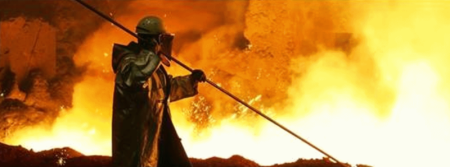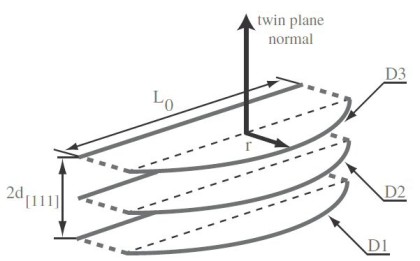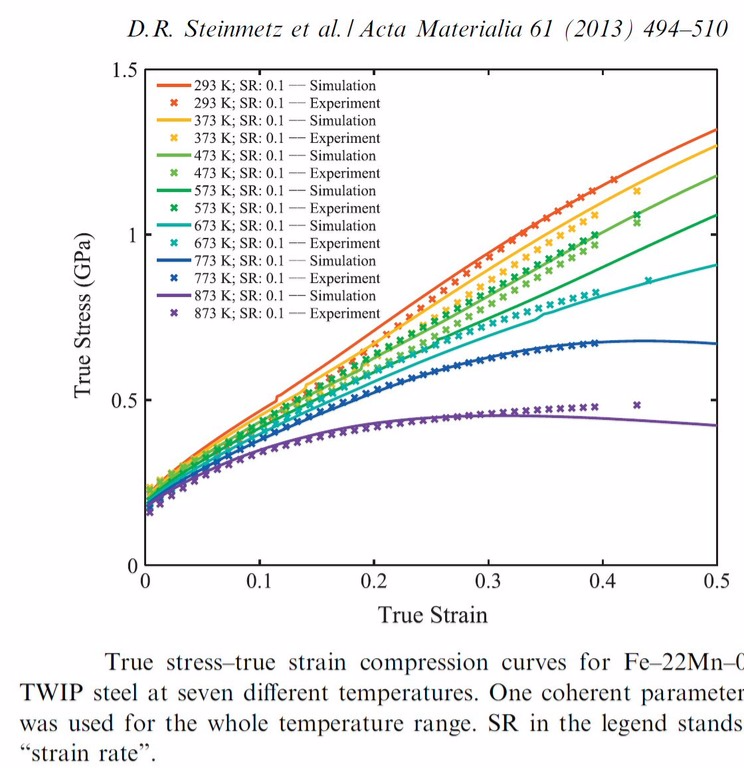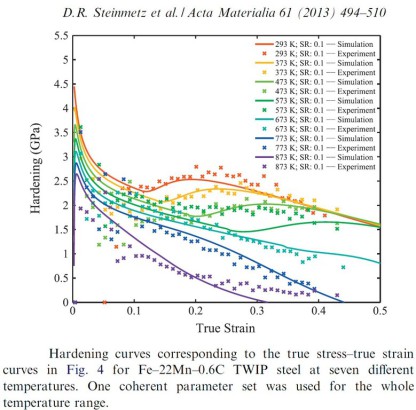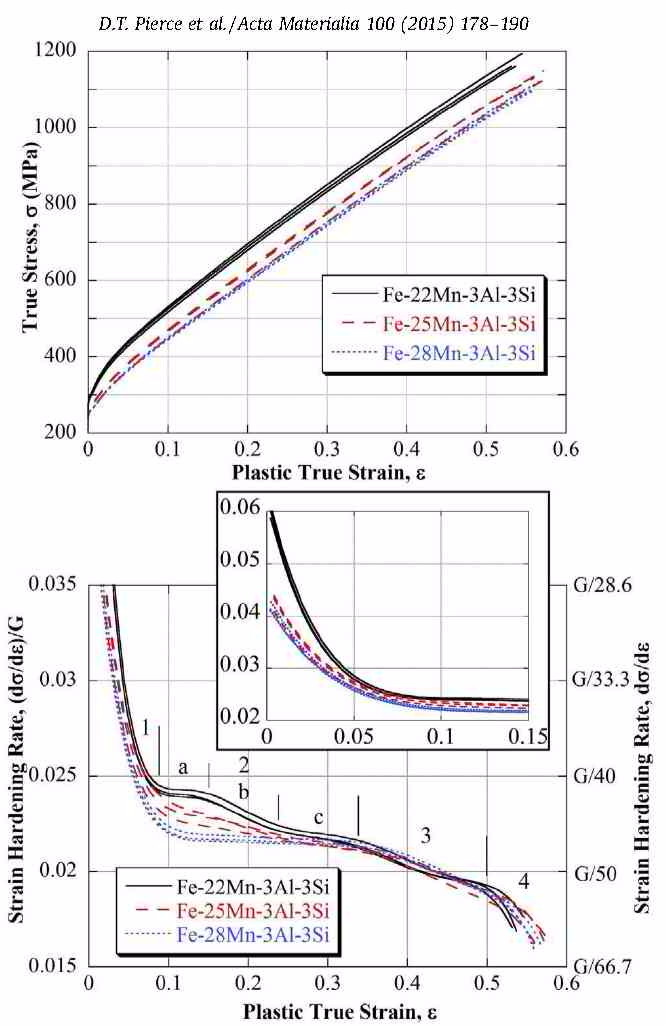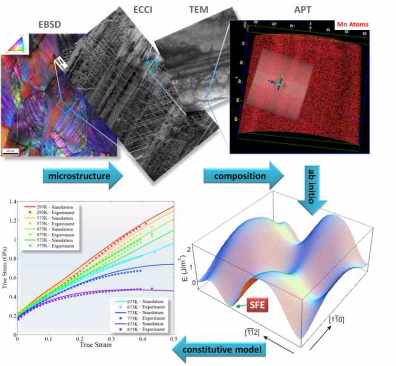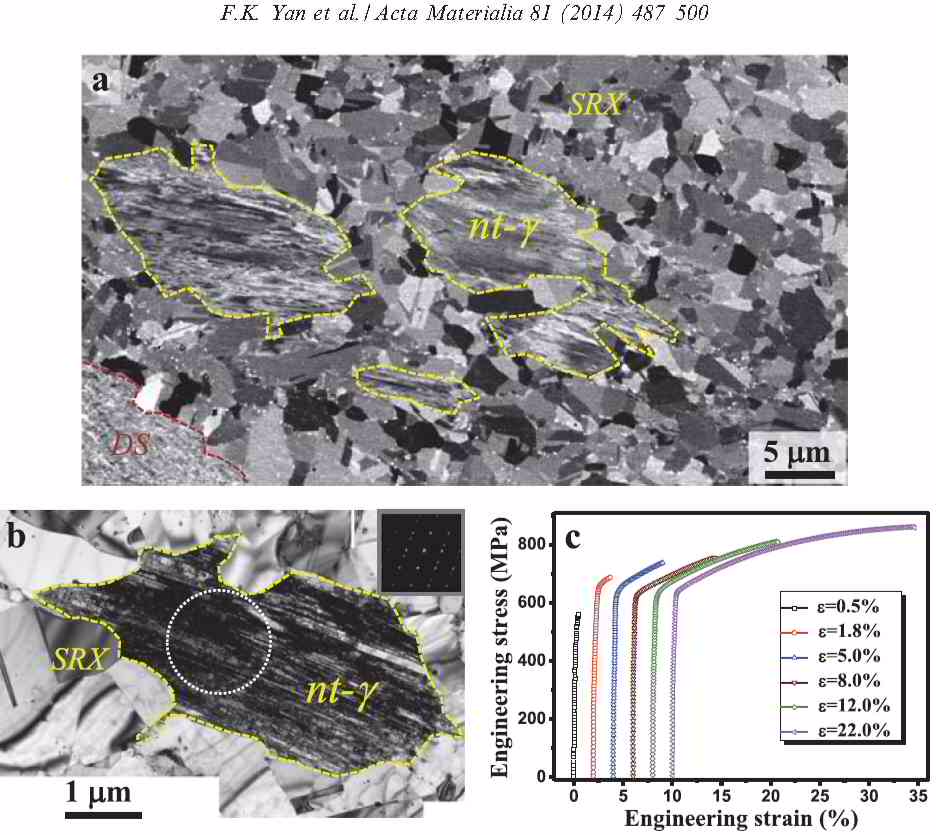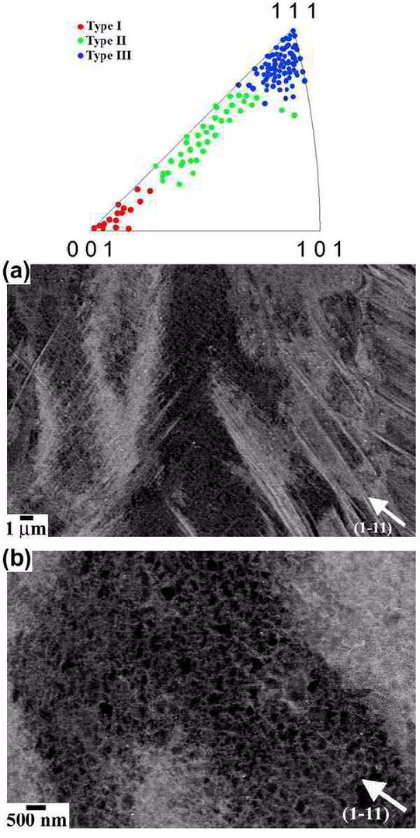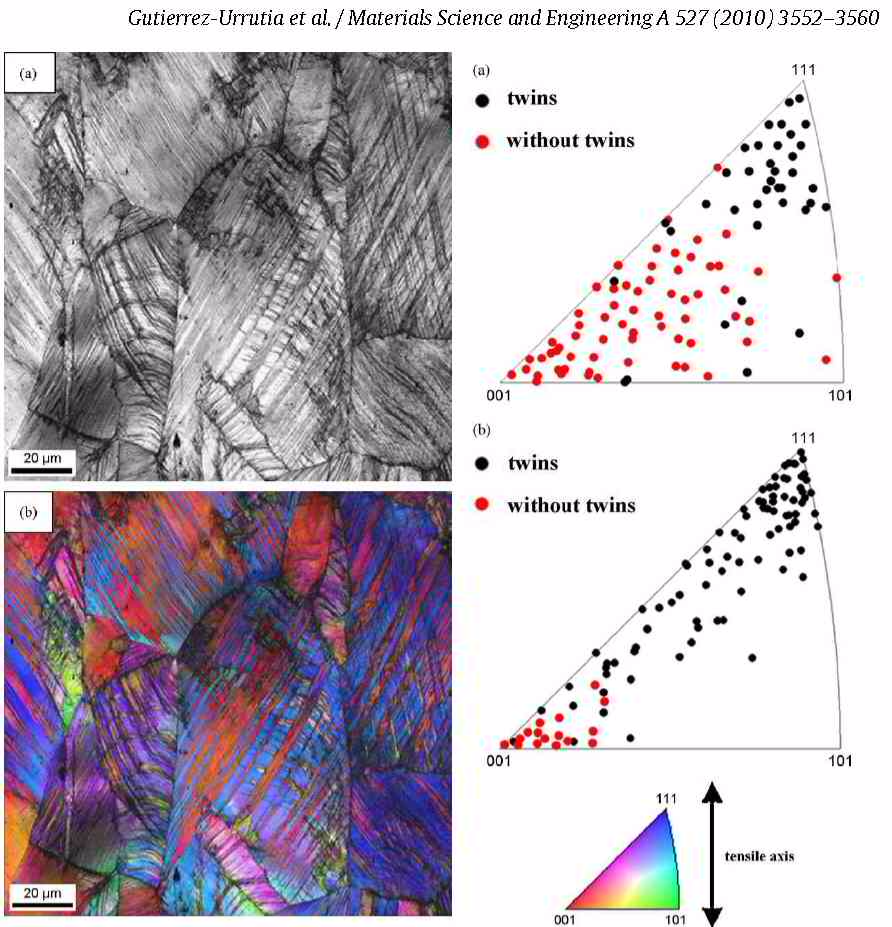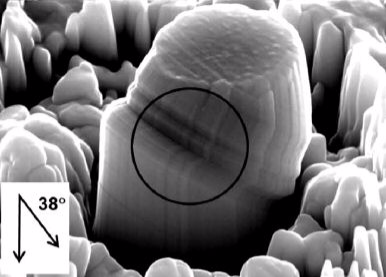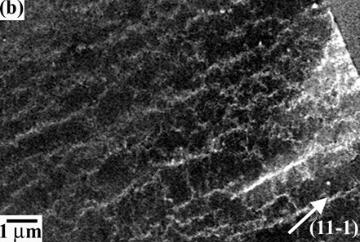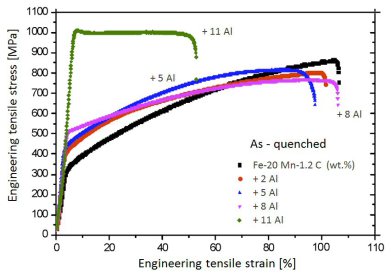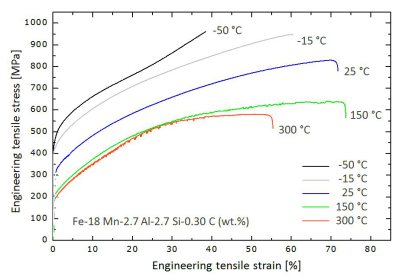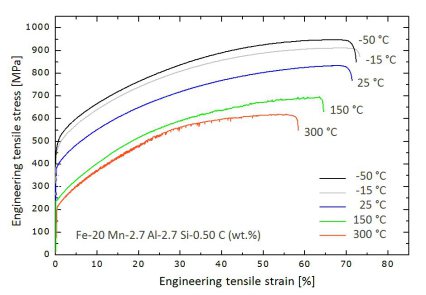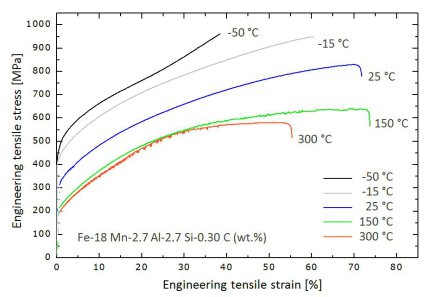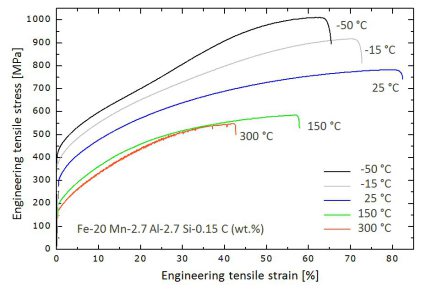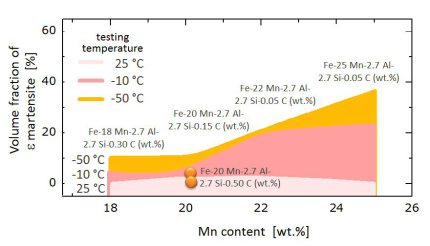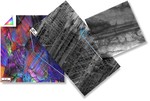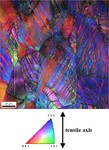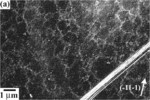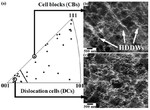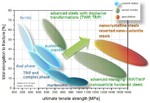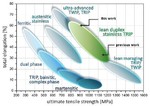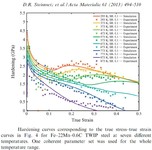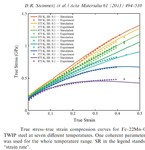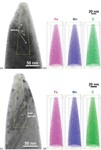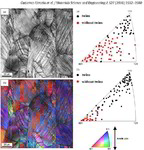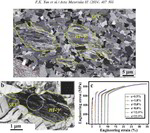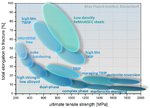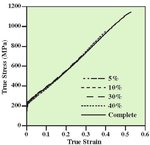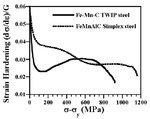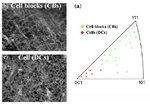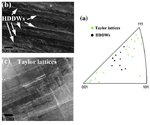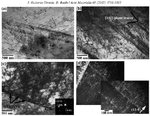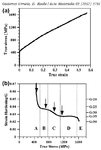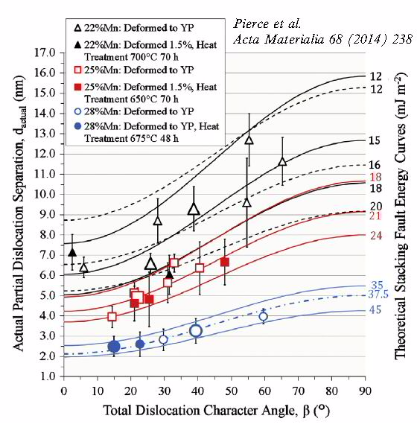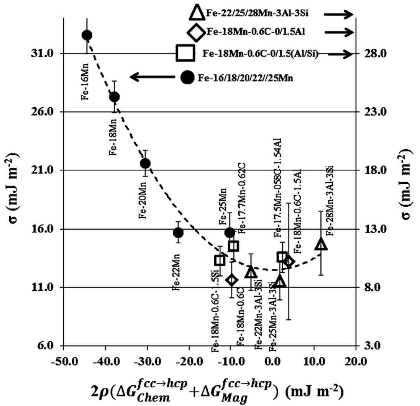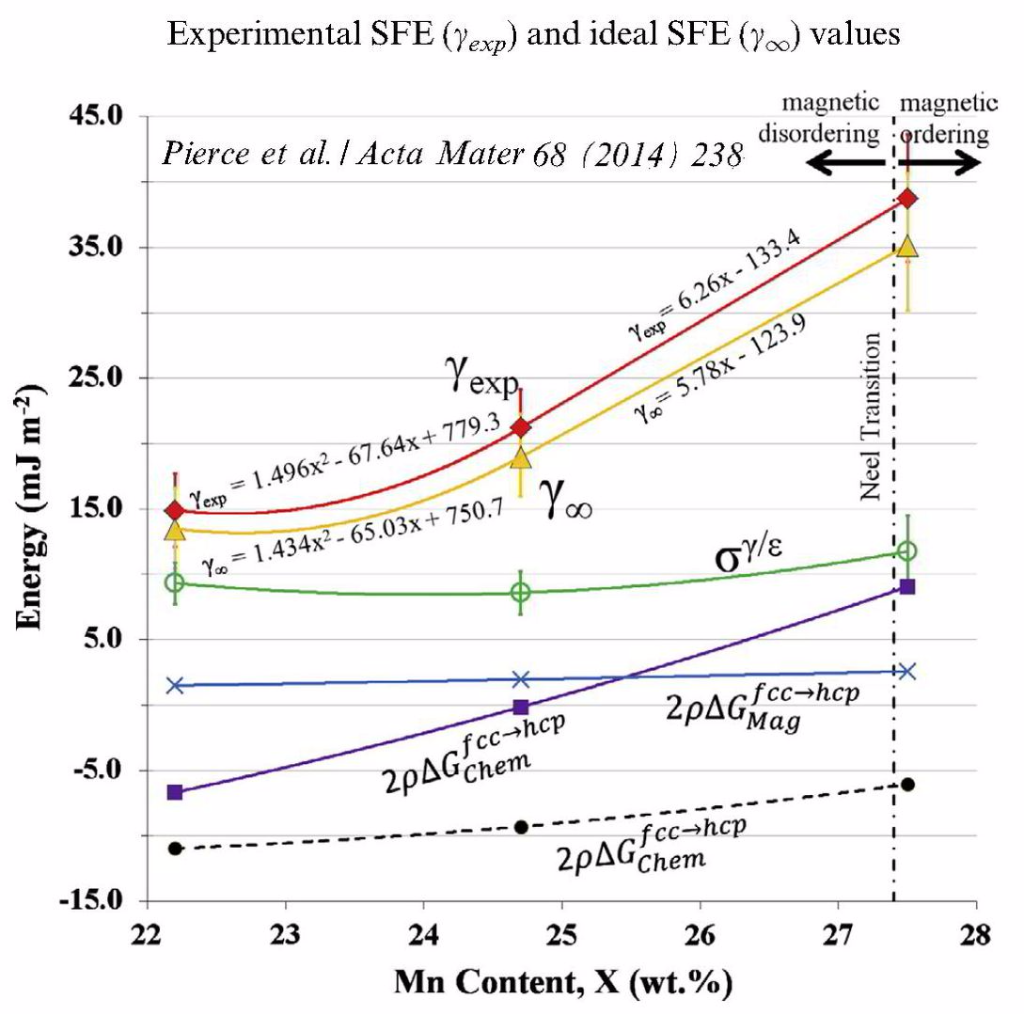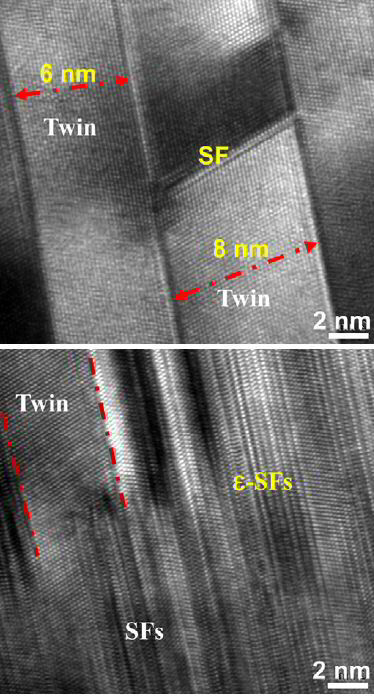TWIP steels (Twinning Induced Plasticity Steels)
Introduction to TWIP Steels
TWIP steels, which stands for twinning-induced plasticity steels, have received very high interest in recent years due to their excellent mechanical properties at room temperature combining high strength (ultimate tensile strength of up to 1 GPa ) and ductility (elongation to fracture up to 100 %) based on a high work-hardening capacity. TWIP steels are austenitic steels, i.e. face-centered cubic (fcc) metallic alloys, with high content in Mn (above 20% in weight %) and small additions of elements such C (<1 wt.%), Si (<3 wt.%), or Al (<3 wt.%). The steels have low stacking fault energy (between 20 and 40 mJ/m2) at room temperature. The high strain-hardening of TWIP steels is commonly attributed to the reduction of the dislocation mean free path with the increasing fraction of deformation twins as these are considered to be strong obstacles to dislocation glide.
Nucleation model for deformation twinning in TWIP steels
Twin nucleus proposed by Mahajan and Chin as used in the model presented in Acta Materialia 61 (2013) 494–510. d(111) is the interplanar spacing in 111 direction, L0 is the length of the sessile partial dislocations forming the twin nucleus and r is the distance the mobile partial dislocations have bowed out. D1, D2 and D3 are the mobile Shockley partial dislocations which bow out to form the twin.
How to describe strain-hardening in TWIP steels ?
In this project we devloped a multiscale dislocation density-based constitutive model for the strain-hardening behavior in twinning-induced plasticity (TWIP) steels.
The approach is a physics-based strain rate- and temperature-sensitive model which reflects microstructural investigations of twins and dislocation structures in Fe-Mn-C based austenitic TWIP steels. One distinct advantage of the approach is that the model parameters, some of which are derived by ab initio predictions, are physics-based and known within an order of magnitude. This allows more complex microstructural information to be included in the model without losing the ability to identify reasonable initial values and bounds for all parameters.
Dislocation cells, grain size and twin volume fraction evolution are included. Particular attention is placed on the mechanism by which new deformation twins are nucleated, and a new formulation for the critical twinning stress is presented. Various temperatures were included in the parameter optimization process. Dissipative heating is also considered. The use of physically justified parameters enables the identification of a universal parameter set for the example of an Fe–22Mn–0.6C TWIP steel.
In summary in this project we developed a new physics-based constitutive model for low-SFE fcc metals that exhibit deformation twinning which is based on a combination and extension of the 3IVM of Roters et al. and the twin nucleation model of Mahajan and Chin. Dislocation cells, grain size and twin volume fraction evolution are included.
TWIP Steels: Combining Simulation and Experiment for understanding strain hardening
Very good agreement with experimental compression data (Fe–22Mn–0.6C TWIP steel) was found between 293 and 873 K using a single set of physically motivated parameters. The model
reveals that the intermediate strain-hardening
regime that is responsible for the high formability of TWIP steels is due to the dynamic increase of the twin-related interface density and its interaction with
the
dislocations. In addition, due to the good prediction of hardening behavior over a temperature range spanning almost 600 K, the door is now open to the inclusion
of adiabatic heating effects caused by shear banding, the implementation of temperature-sensitive forming simulations and the improvement of failure
simulations. The twin nucleation model introduced follows twinning at the mechanistic level and considers both the dislocation activity necessary to create twin nuclei
and the stress state responsible for the expansion of the nuclei into twins. The nucleation rate of twins is linked directly to the dislocation density, the size of the twin nucleus
and the SFE through the critical twin stress and the probability of formation of the twin nucleus.
The simulated temperature of the sample evolves during deformation owing to dissipation, a phenomenon that has been ignored in models until now, but is vital to include. The predicted
changes in sample temperature during RT compression or tensile testing can exceed 100 K in the case studied here.
The SFE of an alloy, which is the key parameter for twinning, can nowadays be calculated ab initio by density functional theory. In combination with the presented model, it is
therefore possible to tailor the SFE (i.e. the alloy composition) to achieve desired macroscopic properties. This is a big step forward in predictive hierarchical materials
modeling.
Acta Materialia 61 (2013) 494-510
Steinmetz et al.
Revealing the strain-hardening behavior of twinning-induced plasticity steels: Theory, simulations, experiments
Acta Materialia 61 (2013) 494 Strain har[...]
PDF-Dokument [1.8 MB]
How does the stacking fault energy influence strain-hardening in Fe–Mn–Al–Si austenitic and TWIP steels?
High-manganese transformation- and twinning-induced plasticity (TRIP/TWIP) steels are receiving high interest owing to their exceptional combination of strength, ductility and strain-hardening. These alloys show excellent promise for automotive applications as a means to reduce vehicle weight through downgauging and to enable room temperature (RT) forming of complex shaped parts. Typically, high- Mn TRIP/TWIP steels are metastable or stable austenite and besides high levels of Mn (18–30 wt.%) have additions of Al, Si, Cr, C and N. The steels deform by a combination of dislocation glide and secondary deformation mechanisms such as abcc/ehcp-martensite formation and/or mechanical twinning. The martensite platelets and mechanical twins act as planar obstacles and reduce the mean free path of dislocation glide. Dislocations pile up at interfaces between these planar defects and the matrix and cause significant back stresses that impede the progress of similar dislocations. Back stresses contribute a significant amount to the flow stress (up to half the total flow stress in an Fe–22Mn–0.6C wt.% steel). The shear displacements associated with martensite and mechanical twin formation are of secondary importance considering their direct contribution to the total strain. However, the significant work-hardening caused by these planar defects delays local necking and results in large uniform elongations.
The activation of these secondary deformation mechanisms is controlled in part by the temperature- and composition-dependent stacking-fault energy (SFE). With decreasing
SFE, the plasticity mechanisms change from (i) dislocation glide to (ii) dislocation glide and mechanical twinning to (iii) dislocation glide
and fcc-hcp martensitic transformations. In addition, epsilon hcp-martensite can act as nucleation sites for the formation of alpha bcc-martensite. Linking SFE values with specific
plasticity mechanisms is important since each deformation mode may alter the mechanical properties or result in deleterious effects. For
instance, the suppression of ehcp-martensite may reduce the susceptibility
to hydrogen embrittlement and dynamic strain aging (DSA) in some TRIP/TWIP steels.
Effect of stacking-fault energy on the deformation mechanisms in TWIP steels
In this project we aim at a better understanding of the relationship between the stacking-fault energy (SFE), deformation mechanisms, and strain-hardening behavior of high-Mn austenitic transformation and twinning-induced plasticity (TRIP/TWIP) steels. The present study investigates the influence of SFE
on the microstructural and strain-hardening evolution of three TRIP/TWIP alloys (Fe–22/25/28Mn–3A l–3Si wt.%). The SFE is increased by systemically increasing the
Mn content from 22 to 28 wt.%. The Fe–22Mn–3Al–3Si alloy, with a SFE of 15 mJ /m^2, deforms by planar dislocation glide and strain-induced
epsilon hcp- alpha bcc-martensite formation which occurs from the onset of plastic deformation, resulting in improved work-hardening at low strains but lower total elongation.
With an increased SFE of 21 mJ /m^2 in the Fe–25Mn–3Al–3Si alloy, both mechanical twinning and ehcp- martensite formation are
activated during deformation, and result in the largest elongation of the three alloys. A SFE of 39 mJ / m^2 enables significant dislocation cross slip and suppresses epsilon hcp-martensite
formation, causing reduced work-hardening during the early stages of deformation in the Fe–28Mn–3Al–3Si alloy while
mechanical twinning begins to enhance the strain-hardening after approximately 10% strain. The increase in SFE from 15 to 39 mJ / m^2 results in significant changes in the
deformation mechanisms and, at low strains, decreased work-hardening, but has a relatively small influence on strength and ductility.
Acta Materialia 100 (2015) 178-190
The influence of stacking fault energy on the microstructural and strain hardening evolution of Fe–Mn–Al–Si steels during tensile deformation
D.T. Pierce, J.A. Jiménez, J. Bentley, D. Raabe, J.E. Wittig
Pierce Acta Materialia 100 (2015) 178 st[...]
PDF-Dokument [1.5 MB]
How does Hydrogen Embrittlement work in high-Mn Steels?
Hydrogen and fuels derived from it will serve as the energy carriers of the future. The growing demand for hydrogen energy-related infrastructure materials has stimulated multiple
engineering and scientific studies on hydrogen embrittlement resistance of high performance alloys. Among these, high-Mn steels are important owing to their excellent strength - ductility - cost
ratio.
However, hydrogen-induced delayed fracture has been reported to occur in deep-drawn cup specimens of some of these alloys. Driven by this challenge we present in the article below some key
results on hydrogen embrittlement in high-Mn steels. Hydrogen embrittlement susceptibility of high-Mn steels is particularly sensitive to their chemical composition since the various alloying
elements simultaneously affect the material's stacking fault energy, phase stability, hydrogen uptake behavior, surface oxide scales and interstitial diffusivity, all of which affect the
hydrogen embrittlement susceptibility.
int. Journal of Hydrogen Energy 42 ( 2017 ) 12706-12723
Journal Hydrogen Energy 42 ( 2017 ) Hydr[...]
PDF-Dokument [4.6 MB]
Ab Initio Guided Design of Twinning Induced Plasticity Steels
Twinning induced plasticity (TWIP) enables designing austenitic steels with >70% elongation and >1 GPa ultimate tensile strength. They are characterized by
high strain hardening due to the formation of twins and dense dislocation substructures which dynamically reduce the dislocation mean free path. Both mechanisms are governed by the stacking
fault energy which depends on composition. This connection renders these steels ideal model materials for theory-based alloy design: Ab-initio guided composition adjustment is used to tune
the stacking fault energy and thus the strain hardening.
Twins impede dislocation glide. They act as barriers to dislocations, promoting their storage and decreasing their mean free path. Twinning depends on the stacking fault
energy (SFE). In face-centered cubic (fcc) alloys the SFE can be tuned by alloying. This opens compositional access to ‘optimal strain hardening design’. This term refers to a state where
twins and the associated substructures are not forming instantly upon initial yielding but over a wide loading range to enable permanent dynamic reduction of the dislocation mean free glide path and
hence continuous strain hardening. Here we apply this design concept to twinning induced plasticity (TWIP) steels. For understanding how strain-hardening responds to a change in SFE
via alloy tuning, the first step lies in identifying its dependence on composition. With this knowledge the description of strain hardening can be rendered chemistry sensitive. In a second step we
have to understand the underlying strain hardening mechanisms, i.e. twin formation, cross slip, twin–slip, slip–slip and twin–twin interactions.
While the first step is accessible to thermodynamic calculations on the basis of ab initio derived interface energies, the second step can be rendered formal by
mapping the individual strain hardening effects into a mean field model which uses internal variables and couples the twin nucleation rate to the dislocation
substructure and to the SFE. Validation measures are dislocation densities and twin volume fractions determined by electron channeling
contrast imaging (ECCI) and transmission electron microscopy (TEM). Texture and grain size effects are mapped by using electron backscatter diffraction (EBSD).
Ab initio -guided design of twinning-induced plasticity steels
MRS BULLETIN • VOLUME 41 • APRIL 2016
MRS BULLETIN VOL 41 APRIL 2016 page 320 [...]
PDF-Dokument [946.9 KB]
F.K. Yan, N.R. Tao, F. Archie, I. Gutierrez-Urrutia, D. Raabe and K. Lu
Acta Materialia 81 (2014) 487-500
Deformation mechanisms in an austenitic single-phase duplex microstructured steel with nanotwinned grains
Acta Materialia 81 (2014) 487 Nano-twin [...]
PDF-Dokument [2.1 MB]
A novel type of duplex microstructure is generated in a single-phase austenitic steel (AISI 316L; X2CrNiMo19-12), consisting of plastically compliant recrystallized austenitic grains as the
matrix containing coarse non-recrystallized grains with a nanotwinned austenitic (nt-c) structure as strengthening inclusions. This novel type of single-phase yet duplex microstructured steel
exhibits an excellent combination of strength and ductility. We study the plastic co-deformation mechanisms between the nanotwinned and the recrystallized grains under tension using electron
backscatter diffraction (EBSD) and transmission electron microscopy (TEM). At tensile strains below 5%, the nt-c grains nearly deform homogeneously in conjunction with the surrounding
statically recrystallized (SRX) grains without generating notable strain localization near their interfaces. The anisotropic plastic deformation of the nt-c grains with predominant shear
parallel to the twin boundaries results in a higher dislocation density in the neighboring SRX grains. As the strain exceeds 12%, localized deformation occurs within the nt-c grains in the form
of shear banding. A strain gradient is developed in the surrounding SRX grains as a function of distance from the nt-c/SRX interface. Deformation twinning is observed in the SRX grains
near the nt-c grains, while away from nt-c grains dislocation slip dominates the deformation. The strengthening effect of the strong and ductile nt-c grains may offer a novel approach to
strengthen austenitic steels and related alloys by generating a nanotwinned/recrystallized duplex microstructure.
Texture and grain size dependence of deformation twinning in TWIP steels: An ECCI study
In this project we study the kinetics of the substructure evolution and its correspondence to the strain hardening evolution of an Fe–22 wt.% Mn–0.6 wt.% C TWIP steel during tensile deformation by means of electron channeling contrast imaging (ECCI) combined with electron backscatter diffraction (EBSD). The contribution of twin and dislocation substructures to strain hardening is evaluated in terms of a dislocation mean free path approach involving several microstructure parameters, such as the characteristic average twin spacing and the dislocation substructure size. The analysis reveals that at the early stages of deformation (strain below 0.1 true strain) the dislocation substructure provides a high strain hardening rate with hardening coefficients of about G/40 (G is the shear modulus). At intermediate strains (below 0.3 true strain), the dislocation mean free path refinement due to deformation twinning results in a high strain rate with a hardening coefficient of about G/30. Finally, at high strains (above 0.4 true strain), the limited further refinement of the dislocation and twin substructures reduces the capability for trapping more dislocations inside the microstructure and, hence, the strain hardening decreases. Grains forming dislocation cells develop a self-organized and dynamically refined dislocation cell structure which follows the similitude principle but with a smaller similitude constant than that found in medium to high stacking fault energy alloys. We attribute this difference to the influence of the stacking fault energy on the mechanism of cell formation.
Acta Materialia 59 (2011) 6449-6462
Dislocation and twin substructure evolution during strain hardening of an Fe–22 wt.% Mn–0.6 wt.% C TWIP steel observed by electron channeling contrast imaging
I. Gutierrez-Urrutia, D. Raabe
Acta Materialia 59 (2011) 6449 - 6462 TW[...]
PDF-Dokument [1.3 MB]
I. GutierrezUrrutia, S. Zaefferer, D. Raabe
Materials Science and Engineering A 527 (2010) 3552–3560
The effect of grain size and grain orientation on deformation twinning in a Fe–22 wt.% Mn–0.6 wt.% C TWIP steel
Materials Science and Engineering A 527 [...]
PDF-Dokument [818.0 KB]
We investigate the effect of grain size and grain orientation on deformation twinning in a Fe–22 wt.% Mn–0.6 wt.% C TWIP steel using microstructure observations by electron channeling
contrast imaging (ECCI) and electron backscatter diffraction (EBSD). Samples with average grain sizes of 3mm and 50mm were deformed in tension at room temperature to different strains. The
onset of twinning concurs in both materials with yielding which leads us to propose a Hall–Petch type relation for the twinning stress using the same Hall–Petch constant for twinning
as that for glide. The influence of grain orientation
on the twinning stress is more complicated. At low strain, a strong influence of grain orientation on deformation twinning is observed which fully complies with Schmid’s law under the assumption
that slip and twinning have equal critical resolved shear stresses. Deformation twinning occurs in grains oriented
close to <1 1 1>//tensile axis directions where the twinning stress is larger than the slip stress. At high strains (0.3 logarithmic strain), a strong deviation from Schmid’s law is
observed. Deformation twins are now also observed in grains unfavourably oriented for twinning according to Schmid’s law. We explain
this deviation in terms of local grain-scale stress variations. The local stress state controlling deformation twinning is modified by local stress concentrations at grain boundaries
originating, for instance, from incoming bundles of deformation twins in neighboring grains.
Won Seok Choi, Bruno C. De Cooman, Stefanie Sandlöbes, Dierk Raabe
Acta Materialia 98 (2015) 391-404
Size and orientation effects in partial dislocation-mediated deformation of twinning-induced plasticity steel micro-pillars
Acta Materialia 98 (2015) 391 Pillar com[...]
PDF-Dokument [2.0 MB]
Classical theories on deformation twinning in face centered cubic (fcc) metals and alloys suggest that mechanical twinning is initiated in high stress conditions, in stage III hardening,
at low temperatures or in high strain rate deformation conditions. The twin orientation is achieved by a homogeneous shearing of the matrix, which requires the highly coordinated glide
of a/6 < 1 1 2 >-type partial
dislocations with the same Burgers vector, with exactly one dislocation gliding on each successive {111}-type twinning planes. Twinning is initiated after slip on the primary slip system
and the conjugate system has occurred and a high stress is available to activate the twin nuclei formed by dislocation interactions.
The twin formation modifies the prior dislocation structure, with some initially glissile dislocations of the parent crystal being transformed to sessile dislocations in the twin. The
Burgers vector of some dislocations may change when they are transformed in the twin matrix. This process contributes to the strain hardening of the deformation twins [2]. In addition,
the dynamic Hall–Petch
effect [3] also contributes to strain hardening in polycrystals undergoing deformation twinning as twin boundaries are strong obstacles to glide and the formation of micro-twins
gradually reduces the dislocation mean free path. Mechanical twinning in fcc metals does not twin single crystals or grains entirely, and the deformed microstructure always contains
layers with the parent orientation alternating with twinned ones. Several deformation twin formation mechanisms have been proposed for polycrystalline metals and alloys, such as the
emission of dislocations from periodic grain boundaries ledges, which assumes that twins can be generated directly, without the need to form suitable dislocation junctions. Using
molecular dynamics and discrete dislocation dynamics simulation, Weinberger et al. argued that the emission of surface dislocations, nucleated at atomically sharp corners, compensates
for dislocation
starvation during the deformation of micro-pillars in which dislocation starvation occurs. Zhu et al. also argued in favor of twinning by partial dislocation nucleation at
surfaces, but they did not propose an actual mechanism for the generation of partial dislocations from surfaces. There are fundamental problems
with the assumption that surfaces or grain boundaries can be a source of twinning dislocations, such as the fact that the emission of a partial dislocation loop requires a high critical
shear stress, and that twin formation requires a precise partial dislocation sequence, i.e. one single partial dislocation on every {111} type slip plane. Partial dislocation emission
from a surface has not conclusively been shown to be compatible with these requirements.
When small scale compression testing (in a nano-indentation setup) is used to analyze the deformation of micro-pillars, a characteristic size effect is observed [10,11]: the shear stress to
initiate plastic flow increases with decreasing pillar diameter. Greer proposed a dislocation starvation model to explain the size effect. Dislocation source-hardening, which occurs in small samples due to the physical limitation of the dislocation source size, was proposed to account for the considerable strengthening in micron-sized single crystals. The size dependence of the strength of single-ended dislocation sources was verified by three-dimensional discrete dislocation dynamics simulation. Yu reported that the twinning stress in micro-pillars was also size-dependent. Seo et al. suggested that the strength of Au nano-wires, in which twins were formed, was inversely
related to their diameter. Size effects were also reported for TWIP steel micro-pillars deformed in compression. In the present study, the twinning-induced plasticity mechanism of
TWIP steel was studied by means of compression tests
on bulk single crystals and micro-pillars, oriented either for perfect dislocation glide or, respectively, for deformation twinning. Transmission electron microscopy (TEM) was used to
investigate dislocation interactions and the evolution of the deformation microstructure in the micro-pillars. The dislocation interactions were characterized at the initial stage of
the deformation in which
no microstructural evolution had occurred in order to verify whether the yielding mechanism of the micro-pillars was associated with twin formation.
In summary we here study bulk and micro-pillar single crystals regarding the twinning-induced plasticity mechanism in austenitic Fe-22 wt%Mn-0.6 wt%C TWIP steel. Compression of micro-pillars oriented either for deformation-induced twinning or for perfect dislocation glide was carried out for pillars with diameters
in the range of 600 nm to 4 um. The same size dependence of the critical resolved shear stress was observed for both orientations. The critical micro-pillar diameter for size-independent
plasticity was approximately 7.6 um. Partial dislocation-mediated formation of twins and e-martensite was observed
in micro-pillars oriented for twinning by transmission electron microscopy. The elastic–plastic transition in micro-pillars oriented for deformation twinning did not involve twinning, and
dislocation–dislocation interactions were a necessary precondition for twin formation.
A brief Introduction to TWIP steels
Face centered cubic materials such as austenitic steels, TRIP steels, brass, TWIP steels and shape memory alloys deform not only by dislocation slip but also by displacive deformation mechanisms (also referred to as displacive transformations). These mechanisms are characterized by a diffusionless collective motion of clusters of atoms where each atom is shifted by only a small distance relative to its neighbors. Such transformations create shears with kinematics similar to that of dislocations. Here, I present one such mechanism and its application in advanced steel design, namely, mechanical twinning.
The term TWIP stands for 'Twinning Induced Plasticity' and it indicates that twinning often goes along with accomodation plasticity via lattice dislocations. In that context high-manganese steels have received much interest in recent years due to their outstanding mechanical properties combining high strength and ductility. This property profile is attributed to their high strain hardening capacity.
High-manganese steels are typically austenitic steels, i.e. they are face-centered cubic (fcc) alloys, with a high Mn content (above 20% wt.%) and additions of elements such as carbon (<1 wt.%),
silicon (<3 wt.%) and aluminum (<10 wt.%).
This steel grade exhibits different hardening mechanisms, such as transformation-induced plasticity (TRIP), twinning-induced plasticity (TWIP) or microband-induced plasticity (MBIP). The activation of these mechanisms is strongly dependent on the stacking fault energy. TRIP is observed in very low stacking fault steels (below 20 mJ m-2) and is associated with the transformation of austenite (fcc phase) into e-martensite (hexagonal close-packed phase), which in turn further acts as nucleus of a'-martensite (body-centered cubic or tetragonal phase). TWIP is observed in medium stacking fault energy steels (20–40 mJ m-2) and is characterized by the formation of deformation twins with nanometer thickness. MBIP has been recently reported in steel grades with high stacking fault energy (ca. 90 mJ m-2) and is attributed to the formation of microbands, which are in-grain shear zones that are confined by geometrically necessary boundaries or conventional grain boundaries. These microstructure features (e-martensite plates, deformation twins and microbands) lead to a remarkable variety of strain hardening phenomena as they all act as effective obstacles for dislocation glide. High-manganese TWIP steels are characterized by a hierarchical microstructure refinement that includes complex dislocation and twin substructures, and their interactions. Although there are some previous studies on the strain hardening behavior in TWIP steels, the details of the underlying kinetics of the substructure evolution and its correspondence to the stress–strain and strain hardening evolution is not yet fully understood.
JOM 66, No. 9, 2014 page 1845 Low-Densit[...]
PDF-Dokument [2.4 MB]
TWIP-model-experiments-Acta-Nov-2013.pdf
PDF-Dokument [1.8 MB]
Acta 59 (2011) ECCI-Fe-Mn-C.pdf
PDF-Dokument [2.5 MB]
Scripta-Mater-68 (2013) 343–weight-reduc[...]
PDF-Dokument [721.1 KB]
Mater Sc Techn 2014 VOL 30 1099 weight r[...]
PDF-Dokument [390.1 KB]
Low temperature properties of TWIP steels
The room temperature ductility of many Fe- Mn TWIP steels is very high, exceeding in part 80% engineering tensile elongation. What is even more interesting though is the excellent ductility
also at very low testing temperatures such as at -15° C and -50° C. At these cryogenic conditions the material still reaches 60 to 70% elongation,
respectively, at an even strongly increased flow stress. The sample tested at -50° C reaches a tensile strength of 1 GPa. Some of the data shown below reveals the corresponding volume fractions
of martensite after deformation (taken at elongation to fracture). These data suggest that this enormous increase in strength at cryogenic conditions can be essentially attributed to the
formation of martensite which is approaching 80% for this material at the fracture point. This very high volume fraction of deformation induced martensite explains the excellent ductility and
strength at the low testing temperatures. Also, the slightly concave shape of the stress-strain curve indicates that at -50°C very pronounced formation of martensite between 20 and 30%
engineering strain. This mechanism leads to an additional contribution to the total strain hardening at this stage, explaining the very high ultimate tensile strength observed for this
material.
Very similar stress-strain results, however, with ductility values typically not exceeding 50-55%, are also observed for conventional austenitic stainless steels such as the standard grade 304
(1.4301) which contains about 18 wt.% Cr and 8 wt.% Ni and for certain duplex stainless steels with metastable austenite. These materials also show a similar increase in the
flow stress when deformed at temperatures below room temperature, also due to deformation-induced martensite. However, they show much smaller values in the elongation to fracture compared to
the Fe-Mn TWIP alloys.
References for TWIP steels
The coupling of electron channeling contrast imaging (ECCI) with electron backscatter diffraction (EBSD) provides an efficient and fast approach to perform ECCI of crystal defects, such as dislocation
ECCI Overview JOM 2013.pdf
PDF-Dokument [812.0 KB]
Acta Materialia 68 (2014) 238-253
D.T. Pierce, J.A. Jimenez, J. Bentley, D. Raabe, C. Oskay, J.E. Wittig
The influence of manganese content on the stacking fault and austenite/epsilon-martensite interfacial energies in Fe–Mn–(Al–Si) steels investigated by experiment and theory
Acta Materialia 68 (2014) 238 TWIP steel[...]
PDF-Dokument [1.0 MB]
High-manganese austenitic transformation- and twinning-induced plasticity (TRIP/TWIP) steels are a superior class of materials that exhibit excellent strain hardening, strength,
ductility and toughness [1–8]. This combination of mechanical properties is attractive for automotive applications requiring high room-temperature formability and weight reduction.
These alloys typically include
18–30 wt.% Mn and additions of Al, Si, Cr, C and N with microstructures of meta-stable or stable austenite [9–12]. During straining, the austenite deforms by dislocation glide together
with secondary deformation mechanisms, includ-
ing abcc/ehcp-martensite formation and/or mechanical twinning [13]. The martensite platelets and mechanical twins act as
planar obstacles and reduce the mean free path of dislocation glide. As deformation progresses, these
strain-
induced features increasingly refine the grain structure, causing a dynamic Hall–Petch effect [5,14–22]. The result is high strain hardening, delayed necking and large
uniform elongations [1]. A separate theory attributes the strain hardening in high-Mn steels containing a significant C content to dynamic strain aging (DSA) and not
mechanical twinning [23]; however, more recent reports [22] conclude
that DSA plays only small role in the hardening compared to mechanical twinning. The low stacking fault energy (SFE) of these steels allows for secondary deformation mechanisms
(the TRIP/TWIP effect). With decreasing SFE, the plasticity mechanisms change from (i) dislocation glide to (ii) disloca-
tion glide and mechanical twinning to (iii) dislocation glide and cfcc! ehcp martensitic transformations [3,24–28]. Each deformation mode results in different mechanical properties.
Consequently, designing TRIP/TWIP alloys requires
a reliable method of predicting SFE. Many studies correlate microstructural observations of deformation mechanisms and mechanical properties with
thermodynamic calculations of the SFE. The method proposed by Olson and Cohen [29], and adapted by several other authors [3,12,25,27], treats the fault as n layers of hexagonal close-packed
(hcp) phase separated from the face-centered cubic (fcc) matrix by two interfaces.
In this paper the stacking fault and interfacial energies of three transformation- and twinning-induced plasticity steels (TRIP/TWIP) (Fe–22/25/ 28Mn–3Al–3Si wt.%) were determined by experimental and theoretical methods. Analysis of Shockley partial dislocation configurations in the three alloys using weak-beam dark-field transmission electron microscopy yielded stacking fault energy (SFE) values of 15 ± 3, 21 ± 3 and 39 ± 5 mJ m^-2 for alloys with 22, 25 and 28 wt.% Mn, respectively. The experimental SFE includes a coherency strain energy
of 1–4 mJ m^-2, determined by X-ray diffraction, which arises from the contraction in volume of the stacking fault upon the face-centered cubic (fcc) to hexagonal close-packed (hcp) phase
transformation. The ideal SFE, computed as the difference between the experimental SFE and the coherency strain energy, is equal to14 ± 3, 19 ± 3 and 35 ± 5 mJ /^-2, respectively. These SFE values
were used in conjunction with a thermodynamic model developed in the present work to calculate the free energy difference of the fcc and hcp phases
and to determine a probable range for the fcc/hcp interfacial energy in the three Fe–Mn–(Al–Si) steels investigated. In addition, the interfacial energies of three Fe–18Mn–0.6C–0/1.5(Al/Si) TWIP and
five Fe–16/18/20/22/25Mn binary alloys were also determined from experimental data in the literature. The interfacial energy ranged from 8 to 12 mJ m^-2 in the TRIP/TWIP steels and from 15
to
33 mJ m^-2 in the binary Fe–Mn alloys. The interfacial energy exhibits a strong dependence on the difference in Gibbs energy of the individual fcc and hcp phases. Accordingly, an empirical
description of this parameter is proposed to improve the accuracy of thermodynamic SFE calculations.
Acta Materialia 83 (2015) 37: We report on the characterization of grain boundary (GB) segregation in an Fe–28Mn–0.3C (wt.%) twinning-induced plasticity (TWIP)
steel. After recrystallization of this steel for 24 h at 700 C, 50% general grain boundaries (GBs) and 35% R3 annealing twin boundaries were observed (others were high-order R and low-angle GBs). The segregation of B, C and P and traces of Si and Cu were detected at the general GB by atom probe tomography (APT) and quantified using ladder diagrams. In the case of the R3 coherent annealing twin, it was necessary to first locate the position of the boundary by density analysis of the atom probe data, then small amounts of B, Si and P segregation and, surprisingly, depletion of C were detected. The concentration of Mn was constant
Acta Mater 2014 GB segregation twin TWIP[...]
PDF-Dokument [665.4 KB]
Acta Materialia 97 (2015) 305-315
Suppression of twinning and phase transformation in an ultrafine grained 2 GPa strong metastable austenitic steel: Experiment and simulation
Y.F. Shen, N. Jia, Y.D. Wang, X. Sun, L. Zuo, D. Raabe
Acta Materialia 97 (2015) 305 UFG stainl[...]
PDF-Dokument [1'008.3 KB]
Non-alloyed metallic materials can be equipped with ultrahigh strength by employing heavy plastic deformation and/or by creating ultrafine-grained (UFG) microstructures. Here UFG materials are
defined as polycrystalline solids with property-controlling grain structures below the scale of 1um. Typical processing routes include severe plastic deformation (SPD), which decomposes grains
through dislocation accumulation and reorganization (polygonization). Several different SPD processes for manufacturing bulk materials typically include equal-channel angular pressing (ECAP),
high-pressure torsion (HPT) and accumulative roll-bonding (ARB). In case of steels, UFG structures can also be obtained via thermomechanical processing, exploiting the interplay between plastic
deformation, recrystallization and phase transformation. One of the main motivations for obtaining very fine grains is motivated by the increase in mechanical strength according to the
Hall–Petch relationship. However, such enabled UFG structured ultra-high strength metals often loose ductility compared to their conventional coarse-grained (CG) counterparts. The drop in ductility
of UFG metals is attributed to inhomogeneous deformation at microstructural level, leading to early plastic localization and the premature onset of damage.
For example, a nano-grained (NG) 316L austenitic stainless steel (with an average grain size of 40 nm) prepared via surface mechanical attrition treatments exhibits an extremely high yield
strength of 1450 MPa, whereas the ductility is limited to a few percent.
Various strategies have been proposed for simultaneously increasing the ductility and strength of UFG pure copper and nanostructured alloys. In pure copper, high ductility can be achieved without
sacrificing strength by introducing a high density of pre-existing twins and a large fraction of high-angle grain boundaries. These encouraging results motivated the current study in an effort to
obtain both, high strength and good ductility from a bulk alloy.
In this work an ultrafine-grained 304 austenitic 18 wt.% Cr–8 wt.% Ni stainless steel with a grain size of 270 nm was synthesized by accumulative rolling (67% total reduction) and annealing (550 °C,
150 s). Uniaxial tensile testing at room temperature reveals an extremely high yield strength of 1890 +/- 50 MPa and a tensile strength of 2050 +/- 30 MPa, while the elongation reaches 6 +/- 1%.
Experimental characterization on samples with different grain sizes between 270 nm and 35 lm indicates that both, deformation twinning and martensitic phase transformation are significantly
retarded with increasing grain refinement. A crystal plasticity finite element model incorporating a constitutive law reflecting the grain size-controlled dislocation slip and deformation twinning
captures the micromechanical behavior of the steels with different grain sizes. Comparison of simulation and experiment shows that the deformation of ultrafine-grained 304 steels is dominated by the
slip of partial dislocations, whereas for coarse-grained
steels dislocation slip, twinning and martensite formation jointly contribute to the shape change.

